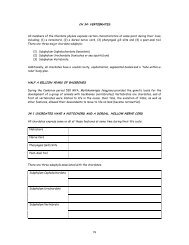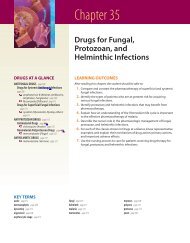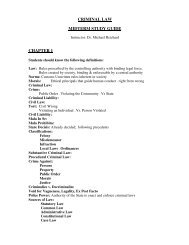Antimicrobial Drugs
Antimicrobial Drugs
Antimicrobial Drugs
You also want an ePaper? Increase the reach of your titles
YUMPU automatically turns print PDFs into web optimized ePapers that Google loves.
M34_ADAM9811_03_SE_CH34.QXD 12/30/09 1:16 PM Page 488<br />
488 Unit 5 The Immune System<br />
TABLE 34. 4 Tetracyclines<br />
Drug Route and Adult Dose (max dose where indicated) Adverse Effects<br />
demeclocycline (Declomycin) PO; 150 mg every 6 h or 300 mg every 12 h (max: 2.4 g/day) Nausea, vomiting, abdominal cramping, flatulence,<br />
doxycycline (Vibramycin, others)<br />
PO/IV; 100 mg bid on day 1, then 100 mg/day (max: 200 mg/day)<br />
diarrhea, mild phototoxicity, rash, dizziness,<br />
stinging/burning with topical applications<br />
minocycline (Minocin, others)<br />
PO/IV; 200 mg as single dose followed by 100 mg bid<br />
Anaphylaxis, secondary infections, hepatotoxicity,<br />
tetracycline (Sumycin, others)<br />
PO; 250–500 mg bid–qid (max: 2 g/day)<br />
exfoliative dermatitis<br />
tigecycline (Tygacil)<br />
IV; 100 mg, followed by 50 mg every 12 h<br />
Italics indicate common adverse effects; underlining indicates serious adverse effects.<br />
against a large number of different gram-negative and<br />
gram-positive organisms and have one of the broadest spectrums<br />
of any class of antibiotics. The tetracyclines are listed<br />
in Table 34.4.<br />
34.10 Pharmacotherapy<br />
with Tetracyclines<br />
Tetracyclines act by inhibiting bacterial protein synthesis. By<br />
binding to the bacterial ribosome, which differs in structure<br />
from a human ribosome, the tetracyclines slow microbial<br />
growth and exert a bacteriostatic effect. All tetracyclines<br />
have the same spectrum of activity and exhibit similar adverse<br />
effects. Doxycycline (Vibramycin, others) and minocycline<br />
(Minocin, others) have longer durations of actions and<br />
are more lipid soluble, permitting them to enter the CSF.<br />
The widespread use of tetracyclines in the 1950s and 1960s<br />
resulted in the emergence of a large number of resistant bacterial<br />
strains that now limit their therapeutic utility. They are<br />
drugs of choice for only a few diseases: Rocky Mountain spotted<br />
fever, typhus, cholera, Lyme disease, peptic ulcers caused<br />
by Helicobacter pylori, and chlamydial infections. <strong>Drugs</strong> in<br />
this class are occasionally used for the treatment of acne vulgaris,<br />
for which they are given topically or PO at low doses.<br />
Tetracyclines exhibit few serious adverse effects. Gastric<br />
distress is relatively common with tetracyclines, however,<br />
and patients will tend to take tetracyclines with food. Because<br />
these drugs bind metal ions such as calcium and iron,<br />
Prototype Drug<br />
Therapeutic Class: Antibacterial<br />
❘ Tetracycline (Sumycin, others)<br />
Pharmacologic Class: Tetracycline; protein synthesis inhibitor<br />
ACTIONS AND USES<br />
ADVERSE EFFECTS<br />
Tetracycline is effective against a broad range of gram-positive and gramnegative<br />
organisms, including Chlamydia, Rickettsiae, and Mycoplasma. Its use<br />
has increased over the past decade due to its effectiveness against H. pylori in<br />
the treatment of peptic ulcer disease.Tetracycline is given orally, though it has a<br />
short half-life that may require administration four times per day. Topical and<br />
oral preparations are available for treating acne. An IM preparation is available;<br />
injections may cause local irritation and be extremely painful.<br />
ADMINISTRATION ALERTS<br />
■ Administer oral drug with full glass of water to decrease esophageal and GI<br />
irritation.<br />
■ Administer antacids and tetracycline 1 to 3 hours apart.<br />
■ Administer antilipidemic agents at least 2 hours before or after tetracycline.<br />
■ Pregnancy category D<br />
PHARMACOKINETICS<br />
Onset: 1–2 h<br />
Peak: 2–4 h<br />
Half-life: 6–12 h<br />
Duration: 12 h<br />
Being a broad-spectrum antibiotic,tetracycline has a tendency to affect vaginal,<br />
oral, and intestinal flora and cause superinfections. Tetracycline irritates the GI<br />
mucosa and may cause nausea,vomiting,epigastric burning,and diarrhea.Diarrhea<br />
may be severe enough to cause discontinuation of therapy.Other common<br />
side effects include discoloration of the teeth and photosensitivity.<br />
Contraindications: Tetracycline is contraindicated in patients with hypersensitivity<br />
to drugs in this class.The drug should not be used during the second half<br />
of pregnancy, in children 8 years or younger, and in patients with severe renal or<br />
hepatic impairment.<br />
INTERACTIONS<br />
Drug–Drug: Milk products, iron supplements, magnesium-containing laxatives, and<br />
antacids reduce the absorption and serum levels of tetracyclines.Tetracycline binds<br />
with the lipid-lowering drugs colestipol and cholestyramine, thereby decreasing the<br />
antibiotic’s absorption.This drug decreases the effectiveness of oral contraceptives.<br />
Lab Tests: May increase the following lab values: blood urea nitrogen (BUN),<br />
aspartate aminotransferase (AST), alanine aminotransferase (ALT), amylase, bilirubin,<br />
and alkaline phosphatase.<br />
Herbal/Food: Dairy products interfere with tetracycline absorption.<br />
Treatment of Overdose: There is no specific treatment for overdose.<br />
Refer to MyNursingKit for a Nursing Process Focus specific to this drug.<br />
# 102887 Cust: PE/NJ/CHET Au: ADAMS Pg. No. 488<br />
Title: Pharmacology for Nurses Server: Jobs2<br />
C/M/Y/K<br />
Short / Normal<br />
DESIGN SERVICES OF<br />
S4CARLISLE<br />
Publishing Services

















